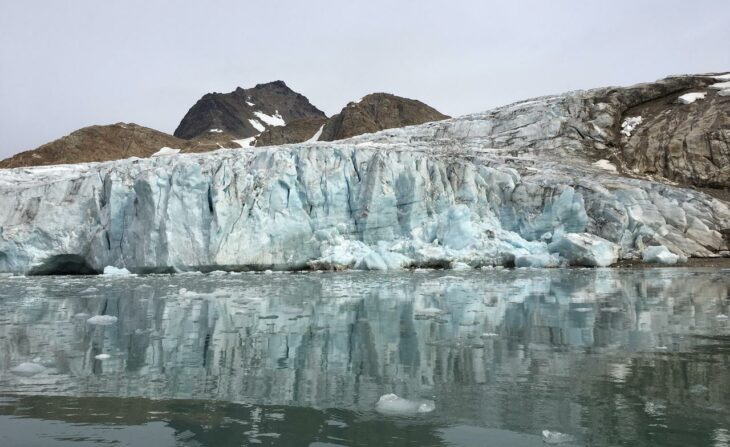Climate change impacts our planet and lives in many ways, from drying the atmosphere to increasing the number of home runs per major league baseball season. Climate change also accelerates the melting of the Greenland Ice Sheet, a land ice mass covering about 80% of Greenland. When glaciers melt, they create icebergs, a process called glacial calving. In recent decades climate change has increased the rate at which the Greenland Ice Sheet releases icebergs into the North Atlantic Ocean.
Scientists found that in the past, significant increases in the rate of glacial calving disrupted an important system of currents in the Atlantic Ocean, collectively called the Atlantic Meridional Overturning Circulation or AMOC. The AMOC brings warm water north and cold water south, influencing temperatures across the globe and moving nutrients throughout the Atlantic Ocean. This means that disrupting the AMOC can change the climate and create instability in marine ecosystems. Recently, scientists did a study to determine whether the present-day increase in glacial calving is likely to disrupt the AMOC.
For this study, the researchers developed a method to quantify glacial output during past periods of increased glacial calving in the North Atlantic that disrupted the AMOC, called Heinrich Events. They started by observing present-day North Atlantic and Arctic glaciers. When icebergs calve, they are loaded with sediment. This sediment includes sand and rocks they picked up from land under the Ice Sheet and the remains of organisms that lived on the Ice Sheet. As icebergs melt at sea, the sediment is released and settles on the ocean floor.
These scientists observed modern glaciers melt to determine the average amount of sediment they release by volume. Using this calculated average, the researchers estimated the volume of ice discharged during past Heinrich Events based on the amount of sediment they deposited on the floor of the North Atlantic.
The scientists used this method to estimate the total ice discharged during 10 Heinrich Events in the last 140,000 years, referred to as the last glacial cycle. Previous scientists had established the length of the Heinrich Events, which allowed these researchers to estimate the rates of ice discharge during each event. When they compared their discharge estimates to the present-day rate of ice discharge, the researchers found that the current ice discharge is similar to that of previous mid-sized Heinrich Events, which disrupted the AMOC. However, the scientists who did this study also pointed out that the AMOC is currently stable.
The researchers suggested 2 factors that may help explain why the present-day increase in glacial calving has not disrupted the AMOC as it did in the past. First, the researchers think the AMOC was stronger when the current rate of ice discharge began to increase than it was at the beginning of past Heinrich Events, which may make the current AMOC more resistant to disruption. Second, each of the 10 Heinrich Events the scientists used in their study lasted approximately 250 years, but the faster calving seen today only began in recent decades. They suggested that disruption to the AMOC may only occur after a longer period of increased glacial calving than what has occurred so far.
If the increased rate of glacial calving must persist for 250 years before the AMOC is disrupted, the size of the Greenland Ice Sheet may limit its potential to impact the AMOC. The researchers pointed out that if the Greenland Ice Sheet continues to melt at its current rate, glacial calving will slow well before 250 years have passed. The icebergs that led to Heinrich Events during the last glacial cycle calved from a much larger ice sheet called the Laurentide Ice Sheet, which no longer exists today.
The scientists who performed this study stated that freshwater runoff from the melting Greenland Ice Sheet can also disrupt the AMOC, but that process has less of an impact than ice discharge. However, they pointed out that freshwater runoff is likely to increase as glacial calving slows in the coming decades, which could have unpredictable consequences. The researchers indicated that the scientific community should continue working to model the impact of the melting Greenland Ice Sheet as accurately as possible because, in their words, “the fate of the AMOC remains precariously unclear.”


